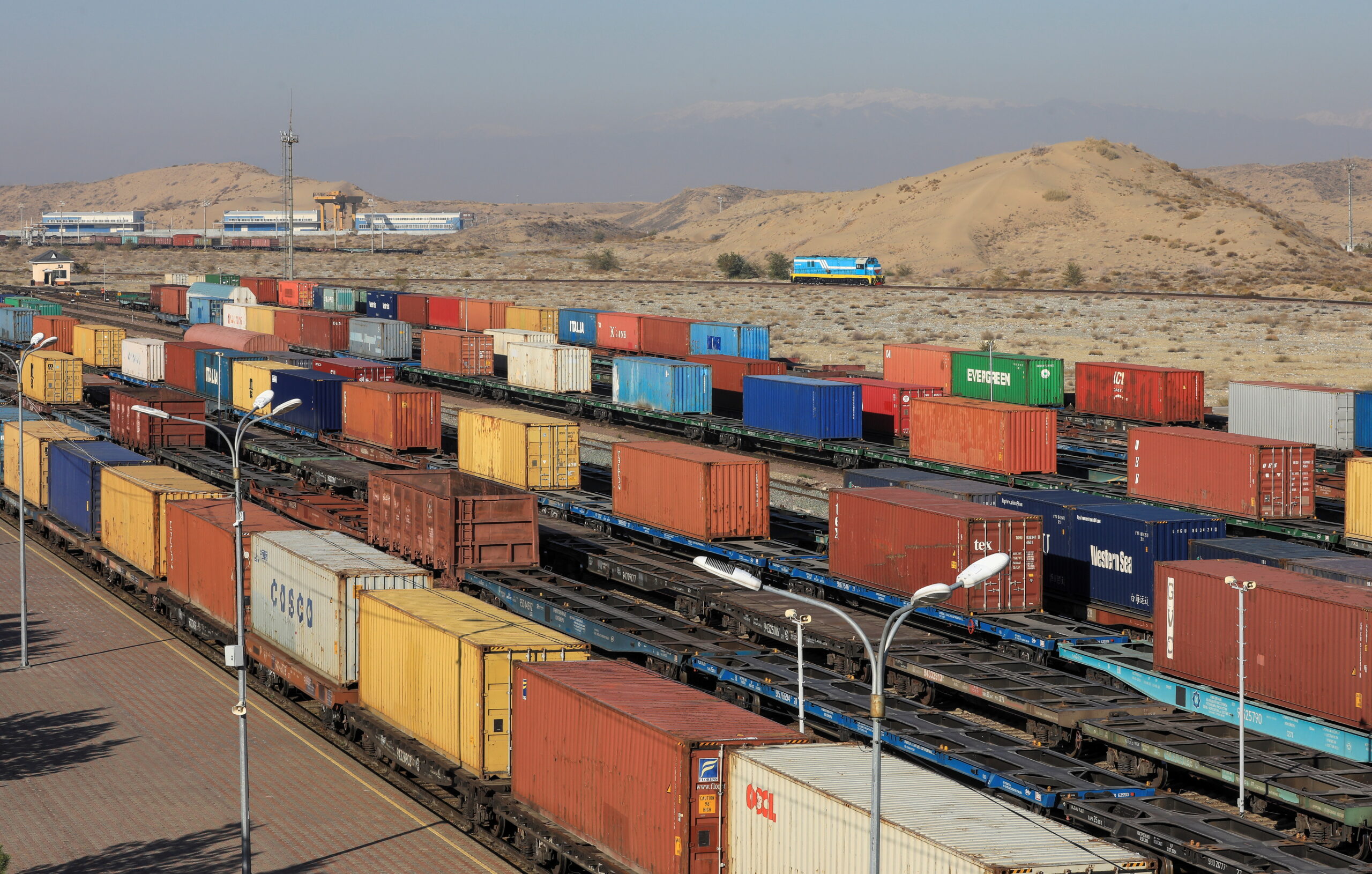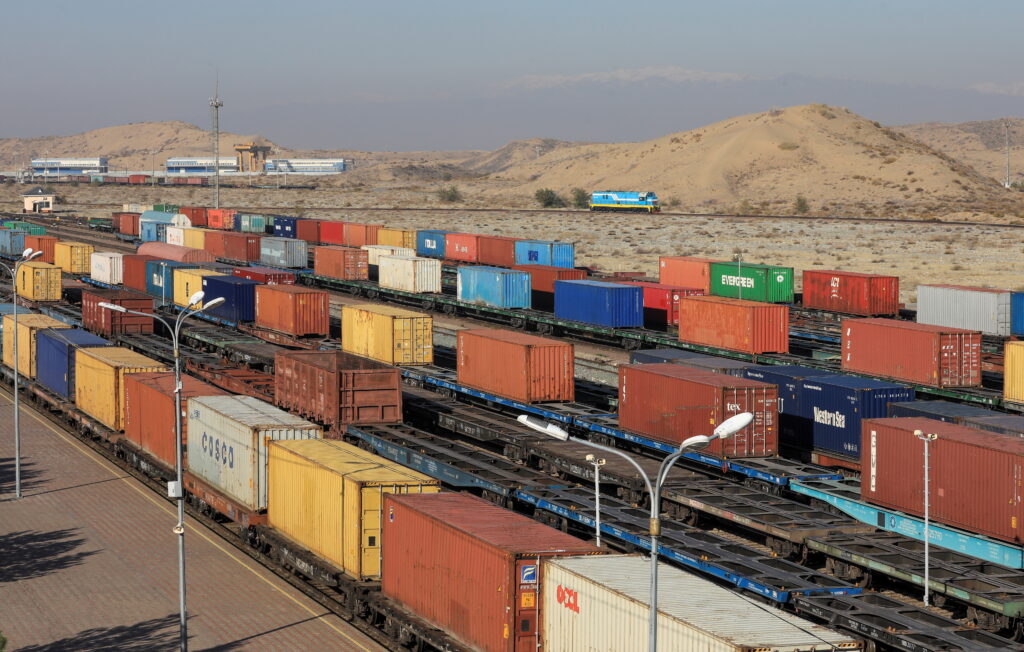There’s an alternative to Russian-based trade routes—but it needs support from the US, EU, and Turkey
Leaders looking for an alternative to trade routes that flow through Russia may already have a potential solution available.
Currently, the primary land-based trade route between Europe and China is the Northern Corridor, a rail-freight system that runs through Russia with a cargo capacity of over one hundred million tons. But following Russia’s full-scale invasion of Ukraine, the Northern Corridor has become a political and financial liability, particularly for NATO allies and partners anxious to reduce dependence on Russia and countries in the West who are reluctant to support Russia and aiming to counter the Kremlin’s adventurism.
In searching for an alternative to the Northern Corridor, one option is the Trans-Caspian International Transport Route (TITR), otherwise known as the Middle Corridor, a multimodal network of railways and ports that begins in China and runs across Central Asia, the Caucasus, and the Black Sea before reaching Europe.
Trade along the Middle Corridor grew from 530,000 tons in 2021 to 2.3 million tons in 2023. In the first six months of 2023, the TITR had reported a 77 percent increase in tonnage over the same time period in 2022, while Northern Corridor tonnage fell by 56 percent. The World Bank estimates with adequate infrastructure investment, TITR trade volume could be as high as eleven million tons by 2030. It is no coincidence that the dramatic increase in the Middle Corridor, along with the precipitous drop in Russian-based freight traffic, has occurred in the period following Russia’s full-scale invasion of Ukraine.
While the TITR may offer a reasonable solution for reducing trade along the Northern Corridor, there are many challenges.
Notably, the TITR’s infrastructure isn’t very modern or integrated across borders, meaning its ability to handle increased freight volume is limited. One source even reported that TITR has only 5 percent of the Northern Corridor’s capacity. Thus, it will be necessary to build out and expand the system. The TITR also suffers from long lead times, often exceeding fifty days. It also presents higher costs: The multimodal nature of the route (rail and seaborne) requires costly transfers of loads from one method of transportation to another, while the number of countries along the route increases administrative costs. These challenges also reduce efficiency and increase shipping time. In fact, these delays and higher costs have subsequently pushed shippers back to the Northern Corridor or to seek alternative maritime routes to the Middle Corridor.
Several countries along the route—notably Azerbaijan, Georgia, Kazakhstan, and Turkey—are stitching together an integrated rail and shipping network that transcends this politically volatile and geographically challenging region. On March 31, 2022, the governments of these countries signed a declaration to improve cooperation along the route. On May 11, 2022, rail executives from Azerbaijan, Georgia, Kazakhstan, and Turkey met in Ankara to discuss the Middle Corridor project. There, they approved an action plan that included measures to modernize the trade network, harmonize tariffs and trade policies, and make cross-border interactions more efficient.
Within a year after the 2021 reinvigoration of the Turkic Council (now called the Organization of Turkic States), Azerbaijan, Turkey, and Kazakhstan signed the Baku Declaration, which was designed to reinforce “existing coordination between the three countries and strengthen regional connectivity.” Kazakhstan provides the longest rail access, and its Caspian port city of Aktau will be expanded to meet demand. On the western side of the Caspian Sea, Azerbaijan’s Baku port—supported by an expansion and modernization program—will forward freight to Georgia and Turkey.
The Baku-Tbilisi-Kars (BTK) railway, also called the “Iron Silk Road,” plays an important role in moving loads westward from the Caspian Sea. Opened in October 2017, BTK travels between Azerbaijan and Turkey via Georgia, a connection that had been closed since the early 1990s due to the Nagorno-Karabakh conflict. Another critical component in the TITR is Georgia’s Black Sea coast, specifically the ports of Batumi, Kulevi, Poti, and Supsa, which provide the route’s final sea-based segment. There are modernization projects underway here, specifically in Poti’s port facilities, and Georgia is cooperating with Azerbaijan and Kazakhstan to develop a new shipping route between Poti and Romania’s Constanța Port. The fifth major port along Georgia’s Black Sea coast, Anaklia, is currently being revitalized, and at one point (according to plans) was slated to be the largest port in the Black Sea.
Western countries have shown interest in developing the Middle Corridor. The route would help provide the infrastructure necessary for the European Union’s economic diversification strategy. In 2022, Danish shipping firm Maersk and Finnish company Nurminen Logistics began increasing their presence along the route. Austria’s OBB Rail Cargo Group has also shown interest in expanding its contribution to east-west trade via the TITR. And at the October 2023 Germany-Central Asia Summit, Berlin announced it will help develop the Middle Corridor under the EU Global Gateway Initiative; the EU also announced that financial institutions have committed to investing ten billion euros in support. The Germany-Central Asia Summit is a sign that the transatlantic community is finally recognizing the region’s strategic importance; Washington has also begun to make such a recognition, in the 2024 National Defense Authorization Act’s Black Sea Security and Development Strategy and in the US Congress passing the most recent package of US support to Ukraine.
China has also shown interest in the Middle Corridor. For example, China had invested in an earlier Anaklia revitalization project when Mikheil Saakashvili was president of Georgia—although subsequent administrations shelved it. This has not lessened Anaklia’s appeal, as Beijing’s interest in the Middle Corridor complements its Belt and Road Initiative (BRI). Indeed, China contributed $1.5 billion for an industrial park at Alat, adjacent to the Port of Baku, in Azerbaijan. Investments to strengthen the Middle Corridor’s infrastructure provide Beijing with greater political and economic influence in Central Asia and the South Caucasus. Russia has tolerated this foray into its “near abroad” for now, likely because a chastened and dependent Kremlin is reluctant to disrupt its burgeoning partnership with Beijing. However, considering Russia’s sensitivity to great-power intrusions into what was once part of the Soviet Union, one can only speculate how long before there is some pushback from Moscow.
While Russia is viewed as the immediate threat to regional stability, the Middle Corridor’s stakeholders are also distrustful of Beijing because of the poor press about the BRI. Thus, there is an opportunity for the private and public sectors in the United States, EU, and Turkey to invest in building resilient supply chains with clear strategic benefits, notably a politically acceptable alternative to the Northern Corridor.
Further support for the TITR from Washington, Brussels, and Ankara would send a strong message to the stakeholder nations as well as to Beijing and Moscow. This would also demonstrate to the regional nations that long-term stability and economic growth can be achieved through closer cooperation with NATO countries and the EU. The United States and its allies have an opportunity to positively impact security and engender goodwill along the Middle Corridor through enhanced trade and infrastructure investment.
Arnold C. Dupuy is a nonresident senior fellow at the Atlantic Council IN TURKEY, a faculty member of the US Naval Postgraduate School, and chair of the NATO Science and Technology Organization’s SAS-183, “Energy Security Capabilities, Resilience and Interoperability.” Follow him on LinkedIn.
The views expressed in TURKEYSource are solely those of the authors and do not necessarily reflect the views of the Atlantic Council, its staff, or its supporters.
Further reading
Image: Trains loaded with containers are seen at the Altynkol railway station near the Khorgos border crossing point on the border with China in Kazakhstan, October 26, 2021. Picture taken October 26, 2021. REUTERS/Pavel Mikheyev



/cloudfront-us-east-2.images.arcpublishing.com/reuters/KD2343GVFBJG5KWQHZYSU7PGHA.jpg)